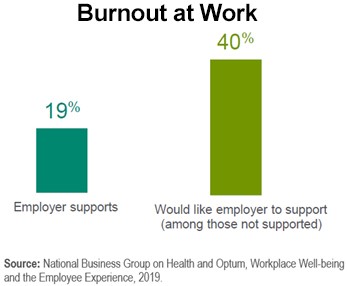
 New survey data from the Business Group and Optum reveal that 19 percent of employees say their employer supports them from getting burned out at work. Among those employees who don’t feel they get adequate support from their employer, 40 percent want help for “burnout at work.” LuAnn Heinen of the Business Group interviewed resilience and neuroscience expert Dr. Amit Sood about the root causes of burnout, employer strategies to prevent and address it, and the most common mistakes he sees across organizations seeking to combat this significant problem.
New survey data from the Business Group and Optum reveal that 19 percent of employees say their employer supports them from getting burned out at work. Among those employees who don’t feel they get adequate support from their employer, 40 percent want help for “burnout at work.” LuAnn Heinen of the Business Group interviewed resilience and neuroscience expert Dr. Amit Sood about the root causes of burnout, employer strategies to prevent and address it, and the most common mistakes he sees across organizations seeking to combat this significant problem.
LuAnn Heinen: Dr. Sood, the World Health Organization is recognizing burnout as a legitimate syndrome resulting from “chronic workplace stress that has not been successfully managed.” What’s your reaction to this?
Dr. Amit Sood: WHO’s recognition is a prudent and responsible step toward finding effective solutions for burnout. It’s important to note, however, that WHO hasn’t categorized burnout as an illness. Instead, WHO has described burnout as an occupational phenomenon, a factor influencing health status or contact with health services.
Today’s workplace stresses us with a combination of demand-resource imbalance, lack of control, and struggle with meaning. Our brain is equipped to handle these stresses in the short term. But when the stressors persist, and the resulting stress becomes chronic, the brain’s adaptive mechanisms decompensate.
The decompensation causes striking neural changes, shifting the brain from a state of thoughtful engagement to reactive disengagement. This neural shift impairs well-being and performance—which in turn further increases stress. Workers locked in this downward spiral experience exhaustion, lose engagement, and begin feeling unworthy—the hallmarks of burnout.
The good news is that burnout has identifiable, and thus reversible, causes. Optimization of stressors and enhancing individual resilience can reverse burnout. Given the strong negative impact of employees’ burnout on their health, relationships, and work performance, finding innovative solutions to prevent and mitigate burnout should be one of the highest priorities of the employers. WHO’s recognition will collectively help us progress in that direction.
Read the full interview here.
